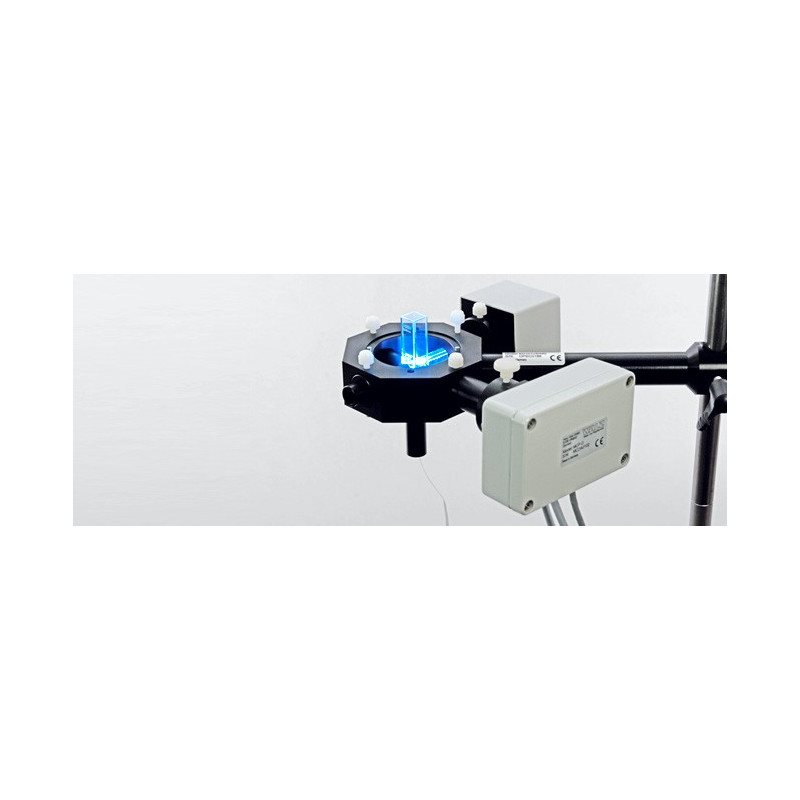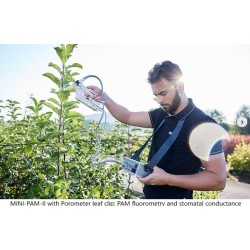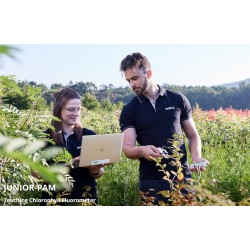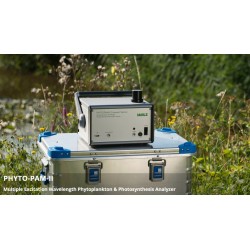MULTI-COLOR-PAM Multiple Excitation Wavelength Chlorophyll Fluorescence Analyzer
The MULTI-COLOR-PAM fluorometer provides an unprecedented color range of measuring and actinic light including white and far-red light sources. The various colors enable researchers to tailor conditions of fluorescence measurements exactly to the spectral properties of their sample.


Therefore, the MULTI-COLOR-PAM fluorometer opens the way to study many wavelength-dependent aspects of photosynthesis that so-far have not been commonly accessible.
he MULTI-COLOR-PAM fluorometer is optimized for highly sensitive assessment of photosynthesis in dilute suspensions of algae, cyanobacteria and chloroplasts. In addition, the measuring system can be configured to study leaf photosynthesis and epidermal UV-A screening.


Data analysis by the MULTI-COLOR-PAM fluorometer includes the option to determine the wavelength-dependent functional PS II absorption cross-section, Sigma(II)λ, and absolute PS II turnover rates, ETR(II)λ. In addition, the MULTI-COLOR-PAM software provides standard saturation pulse quenching analysis and methods for analysis of fast fluorescence changes including polyphasic rise kinetics and dark relaxation of fluorescence with a time resolution of 10 μs.
Power-and-Control-Unit MCP-C
General design: Microcontroller: 2 x AVR-RISC (8 MHz) + 4 MB SRAM; 256000 data points with 12 bit resolution can be stored
Sockets: 2 sockets for measuring light and actinic light of MCP-E Multi-Color Emitter Head, socket for signal detection by MCP-D Detector Head, charge socket or Battery Charger MINI-PAM/L, output socket for PHYTO-MS Miniature Magnetic Stirrer, BNC sockets for 5 V trigger-in and trigger out signals, input socket for US-SQS/WB Spherical Micro Quantum Sensor or US-MQS/WB Mini Quantum Sensor, input socket for auxiliary devices, connector for optional PS I lamp, USB socket
Communication: USB 2.0 and USB 3.0 compatible
User interface: Windows computer with PamWin-3 software
Multi-Color Emitter Head MCP-E
Chip-on-board multi-wavelength measuring light LED emitter: 400, 440, 480, 540, 590, and 625 nm for pulse-modulated measuring light; 20 intensity settings and 14 settings of pulse frequency
Chip-on-board multi-wavelength actinic LED array:440, 480, 540, 590, 625 and 420-640 nm (white) for continuous actinic illumination, max. 4000 μmol
m-2 s-1 PAR; saturating single turnover flashes, max. 200000 μmol-2 s-1 PAR, adjustable between 5 and 50 μs; multiple turnover flashes, max. 12000 μmol-2 s-1PAR, adjustable between 1 and 800 ms
Far-Red LED: peak wavelength 725nm
Dimensions: 10.5 cm x 5.5 cm x 7 cm (L x W x H)
Weight: 500 g (incl. cables, 1 m long)
Power supply: Rechargeable sealed lead-acid battery 12 V/2 Ah; Battery Charger MINI-PAM/L (100 to 240 V AC)
Dimensions: 31 cm x 16 cm x 33.5 cm (W x H x D), aluminum housing with carrying handle
Power consumption: Basic operation 1.6 W, 8 W with all internal light sources operated at maximum output. Saturation Pulse at maximum intensity, 30 W
Weight: 2.5 kg (including battery)
Operating temperature: -5 to +40 °C
Detector Head MCP-D
Signal detection: PIN photodiode with special pulse preamplifier for measuring fluorescence changes with maximum time resolution of 10 μs
Filter box: For up to 14 mm filter thickness
Standard detector filter: long-pass filter > 650 nm (3 mm RG 665) plus short-pass filter SP 710
Dimensions: 6.9 cm x 9.8 cm x 6.4 cm (L x W x H)
Weight: 355 g (incl. cables, 1 m long)
Optical Unit for Suspensions ED-101US/MD
Design: Black-anodized aluminum body with central 10 x 10 mm standard glass cuvette; for attachment of Measuring Heads MCP-E and MCP-D, and Miniature Magnetic Stirrer PHYTO-MS; two additional ports for attachment of two additional devices
Weight: 750 g
Transport Box PHYTO-T
Design: Aluminum box with custom foam packing for MULTI-COLOR-PAM and accessories
Dimensions: 60 cm x 40 cm x 34 cm (L x W x H)
Weight: 5 kg
Saturation Pulse Analysis
Measured: Ft, Fo, Fm, F, Fo' (also calculated), Fm'. Fast polyphasic rise and decay kinetics (time resolution up to 10 μs). PAR using Spherical Micro Quantum Sensor US-SQS/WB or Mini Quantum Sensor US-MQS/WB.
Calculated: Fo' (also measured), Fv/Fm and Y(II) (maximum and effective photochemical yield of PS II, respectively), qL, qP, qN, NPQ, Y(NPQ), Y(NO) and ETR (electron transport rate), C/Fo (constant fraction of Fo not constituting PS II chlorophyll fluorescence)
The MULTI-COLOR-PAM fluorometer can be configured for suspensions (cyanobacteria, algae or chloroplasts) or for flat objects like leaves. Both configurations require the same three components: the MCP-C Power-and-Control-Unit, the MCP-E Multi-Color Emitter Head and MCP-D Detector Head.
For measurements of suspensions, the measuring heads MCP-E and MCP-D are attached to an optical unit (ED-101US/MD) which holds in the center a 1 x 1 x 4.5 cm quartz cuvette. The optical unit guides light efficiently to the sample by a Perspex rod. Similarly, a Perspex rod forms a path with negligible light loss between sample and detector.
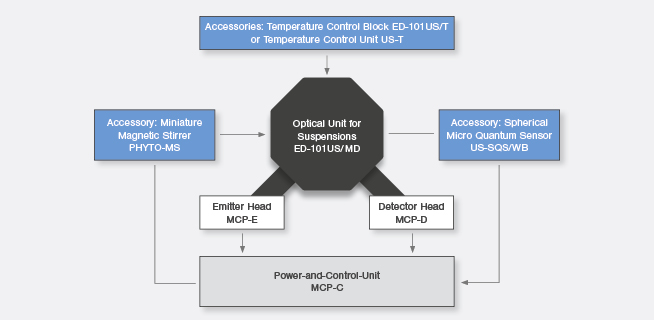
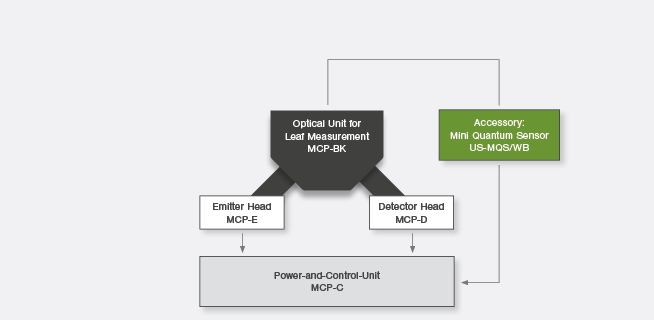
The equipment for measurement of suspension is completed by a number of accessories. The software-controlled stirrer PHYTO-MS prevents settling of particles during measurements. The spherical quantum sensor US-SQS / WB measures light intensity within the suspension and it is a must for measurements of light response curves or functional PS II absorption cross-section. Temperature control can be exercised using the temperature block ED-101 / T connected to a thermostated water bath and mounted on top of the ED-101US / MD optical unit. Alternatively, the US-T unit can control cuvette temperature by a heat-transfer rod dipped into the suspension.
For leaf studies, an optical unit equipped with a leaf clip is used (MCP-BK). Similarly as in the optical unit for suspensions, Perspex rods provide efficient optical pathways between measuring heads and sample where the rod between emitter head and sample is conically shaped to optimize optical efficiency of the unit. For the leaf configuration, the recommended accessory is a cosine-response quantum sensor (US-MQS / WB) which is positioned in a special port of the leaf clip of the optical unit.
- Type of Instrument
- Chlorophyll Fluorometers
- The instrument measures:
- Chlorophyll
You might also like

